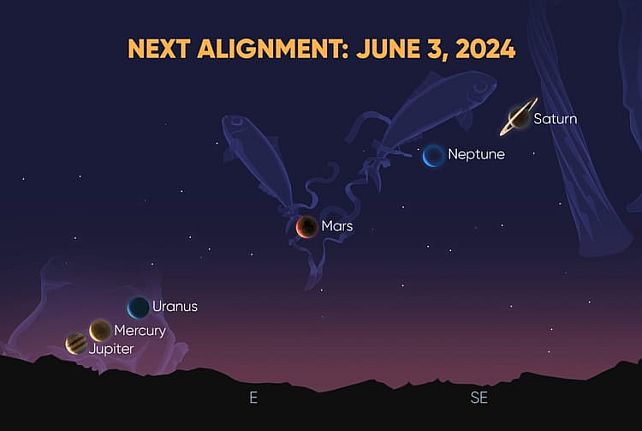Six of the planets of the Solar System are about to line up for a rare sight in Earth's sky.
In the wee small hours of 3 and 4 June 2024, Mercury, Mars, Jupiter, Saturn, Neptune, and Uranus will appear in a straight line in an alignment known as a planet parade. Only Venus will be absent – even Earth's waning crescent moon is going to put in an appearance.
It's not uncommon for several planets to be in the sky at once, but it's less common for more planets to align. Any number of planets from three to eight constitutes an alignment. Five or six planets assembling is known as a large alignment, but five-planet alignments are significantly more frequent than six.
These alignments do not represent the planets lining up in space like you see in diagrams and illustrations of the Solar System. That's not a thing that actually happens in the real Universe, sadly.

A planetary alignment occurs because the planets of the Solar System all orbit the Sun more or less on a flat plane called the ecliptic. Some are a little above or below this plane, but it's roughly the same.
This is because of the way stars form, including the Sun. A baby star in a cloud of material starts spinning; the cloud around them swirls into a disk that feeds into the baby star. A planet forms from what remains of the disk and, if left to its own devices, will stay in that level position.
This means that, occasionally, the planets will be on the same side of the Sun as they move along their orbits, so we get to see them in the sky at the same time. They appear to be in a straight line because they're all on the ecliptic.
This is what will be happening in early June, around an hour before sunrise. You might need some visual aids. While Mercury, Mars, Jupiter, and Saturn will be bright enough to see with the naked eye, Uranus and Neptune are too far and faint, so if you want to catch a glimpse, you'll need binoculars or a telescope.
We have a few more alignments of the same planets coming up in the months ahead, so you might want to mark your calendars accordingly: 28 August 2024 and 18 January 2025 will both see large, six-planet alignments in the pre-dawn hours.
For a truly spectacular sight, hold onto your hats for a full planetary alignment. On the evening of 28 February 2025, all seven other planets will appear in the sky at the same time. That's going to be a very good night for planet-watchers.
How to watch
The alignment will be visible from most locations around the world on June 3. What time the planets rise and set, and in which order, depends on where in the world you're viewing from. There are tools you can access to get those times and sky locations.
Time and Date has an interactive tool that allows you to set the date you want to view, showing the rise and set times for each planet, and where in the sky they can be seen.
Stellarium has a similar web tool that shows you the positions of all the planets.
Sky Tonight is a free mobile app that uses your phone's hardware to gauge where you are located, and shows you real-time positions of celestial objects on a map of the sky above. There is a good list of other options here, too.
Get out there, and go look at some sky.
